|
A couple of years ago, my wife and I decided to take a holiday in Iceland. The minibus tour that we chose was primarily designed to show the natural beauty of the country, and particularly the birds and the geothermal activity. It didn’t seem likely that there would be much time to look for slugs and snails, but nevertheless, it seemed worthwhile to be prepared for anything that might turn up. Google wasn’t helpful in finding a list of Icelandic species, so I did it the hard way: going through the relevant books, and abstracting what information I could (Table 1) In addition, Arion vulgaris (=A. lusitanicus) has recently been recognised as an introduced species. There may be some species that I have inadvertently overlooked, but it is nevertheless clear that the Icelandic non-marine molluscan fauna is quite limited: about 30 species of terrestrial molluscs, and seven freshwater species. The reasons for this limited fauna are fairly obvious. Firstly, Iceland is a relatively remote island, which was not settled permanently until the 9th century. No doubt a few species would have colonised without human intervention, but many would only have arrived from Scandinavia with the Viking colonists. Secondly, it is a long way north (just below the Arctic Circle), with long winters and a short cool summer, so that tender species would not be able to survive. There are several permanent ice caps in the interior, and much of the land is covered with snow and ice for a large part of the year. Finally, because of the volcanic nature of the island – the whole of Iceland has been formed from lava spewing out of the floor of the Atlantic Ocean – much of the land is unsuitable for molluscs. Large areas are covered with lava flows, rocks and ash from volcanic eruptions (Figure 1), and areas with soil of reasonable quality are limited. The soil seems to be very free draining, and even early in the season is very dry, again not very attractive to molluscs. If Google didn’t provide a ready-made list of Icelandic nonmarine molluscs, it did give a warning against investigating freshwater snails. Cases of ‘swimmers’ itch’ in Iceland have been attributed to a schistosome, Trichobilharzia sp., carried by Radix balthica (Skírnisson K, Kolarova L, 2002 Are nasal Trichobilharzia cercariae potential threat to human health? Læknabla_i_ 88, pp 739-44). Schistosomes are often associated with warmer climates, but of course, Iceland has many bodies of freshwater that are geothermally heated. Dabbling in ponds and lakes for snails was therefore to be avoided. Our holiday began with a flight from Glasgow to Iceland, and then a flight from Reykjavik up to Akureyri, the second town of Iceland, in the north (see the map, Figure 2). From here we were driven to our hotel by Myvatn, the ‘Fly Lake’ famous for its numerous breeding ducks and other water birds (Figure 3). Fortunately the flies were not much in evidence in late May! Near the lake shore I found Arion circumscriptus agg., and some very small slugs that were probably Deroceras laeve, under some stones. After three nights here we moved to Akureyri, and managed to fit in a visit to the most northerly botanic garden in the world. As it was May 31st, and the garden didn’t open officially until 1st June, we were advised to enter by a side gate. It was still early spring, and not a lot was growing; however, there were some very small specimens of Radix balthica in a water tank. From Akureyri we headed south, to the area inland from Reykjavik, to see more of the birds and geothermal activity. This was a long drive, but we stopped for a picnic lunch in a wood near Blonduos, where there was a Euconulus fulvus, and some small snail or slug eggs. Icelandic woods consist mainly of small birch trees, and although there are a few logs to turn over, there is often nothing underneath, and the soil remains quite poor. Our destination that night was Geysir, famed for its geysers, of course. We had a couple of nights here, using it as a base to visit various places of interest in the area. Although Geysir (the eponymous geyser) itself rarely performs these days, there are other geysers that go off regularly, and one can sit in the dining room of the hotel and watch them while enjoying one’s meal. The area immediately around the geysers is completely sterile: not only is the water very hot, it is also very rich in minerals, and has a strongly sulphurous smell (Figure 4). Away from this area, round the back of the hotel, however, there were some areas beside a track that proved to be quite profitable, at least by Icelandic standards. Here I discovered Arion distinctus, Arion silvaticus (both confirmed by subsequent dissection), Vitrina pellucida, and Deroceras reticulatum. I have not been able to discover if this is the first identification of A. distinctus, as opposed to A. hortensis agg., in Iceland. Not far from Geysir is one of Iceland’s greatest waterfalls, Gullfoss (Figure 5). Even by Icelandic standards it is very impressive, and it seems incredible that some years ago there was a scheme, happily defeated, to obliterate it with a hydro-electric scheme. Here there were an immature Cochlicopa sp., and what was looked like another Arion distinctus. Another excursion from Geysir took us to the south coast, where a village called Stokkseyri yielded something a bit different. Although the coast here was very rocky, there was a bit of sand between the rocks, possibly with some limey material derived from marine molluscs in it. At any rate, there were snails here, or rather snail shells, instead of the slugs generally found hitherto. Two species were present, in some numbers: Pupilla muscorum and Vitrina pellucida. And so, in a week’s holiday, I found nine species of non-marine molluscs. I had not been trying hard, and there had been rather few opportunities, but even so, this number of species would be regarded as a poor total just for a day’s outing in the British Isles. On the other hand, this represents almost a quarter of the Icelandic species, which sounds more impressive! Some areas we visited yielded no molluscs at all. Thorsmork, a well-wooded area near the south coast, produced nothing, while on our final, wet day in Reykjavik, which should have induced slugs and snails to come out, nothing turned up even in the leafy suburbs. Nowhere were molluscs common. It was, of course, early in the season, but it did seem that Iceland is far from being a rich place for slugs and snails. It is, however, a beautiful and fascinating place, and with a tiny population of about 300,000, most of whom live in or around the Reykjavik area, there is a lot of wild untouched space that has never been farmed or developed. It is well worth a visit, whether or not you find any snails. |
1 A laval landscape, Hafnarberg, Iceland, completely unsuitable for molluscs
|
Table 1. Slugs and snails recorded in Iceland (names updated according to Anderson, 2005, Journal of Conchology 38, pp 607–637) Land molluscs (from Kerney & Cameron, 1979 A Field Guide to the Land Snails of Britain and North-west Europe)
| Oxyloma elegans | All round Iceland |
| Cochlicopa lubrica | All round Iceland |
| Cochlicopa lubricella | SW Iceland |
| Columella edentula | SE Iceland |
| Columella aspera | SE Iceland |
| Vertigo modesta | N and SE Iceland |
| Pupilla muscorum | N and E Iceland |
| Punctum pygmaeum | SW and E Iceland |
| Arion ater | All round Iceland |
| Arion vulgaris (=A. lusitanicus)* | |
| Arion subfuscus | All round Iceland |
| Arion fasciatus | S Iceland |
| Arion circumscriptus | SW and E Iceland |
| Arion silvaticus | SW and E Iceland |
| Arion hortensis agg. | N and SW Iceland |
| Arion intermedius | S Iceland |
| Vitrina pellucida | All round Iceland |
| Vitrea crystallina | S Iceland |
| Vitrea contracta | S Iceland |
| Nesovitrea hammonis | All round Iceland |
| Oxychilus alliarius | All round Iceland |
| Zonitoides nitidus | SW Iceland |
| Lehmannia marginata | All round Iceland |
| Deroceras laeve | All round Iceland |
| Deroceras agreste | All round Iceland |
| Deroceras reticulatum | All round Iceland |
| Euconulus fulvus | All round Iceland |
| Balea perversa | SE Iceland |
| Arianta arbustorum | NW and E Iceland |
| Cepaea hortensis | SW Iceland |
Freshwater Snails from Glöer, P. 2002 Die Süsswassergastropoden Nord- und Mitteleuropas)
| Hydrobia neglecta | Galba truncatula |
| Radix balthica | Anisus spirorbis |
| Anisus leucostoma | Gyraulus laevis |
* Weidema, I. (2006): NOBANIS – Invasive Alien Species Fact Sheet –Arion lusitanicus. – From: Online Database of the North European and Baltic Network on Invasive Alien Species – NOBANIS www.nobanis.org, Date of access 12/7/2007.

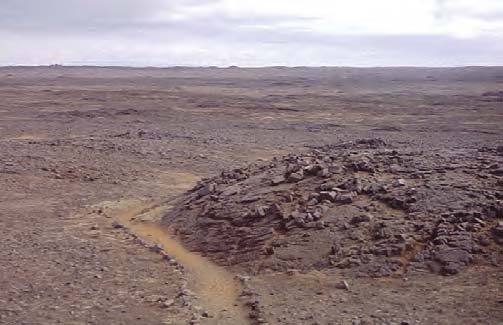
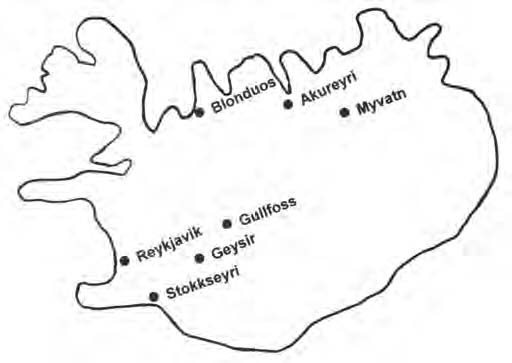 2 Sketch map of Iceland, showing the approximate location of the sites mentioned in the text where slugs and snails were found
2 Sketch map of Iceland, showing the approximate location of the sites mentioned in the text where slugs and snails were found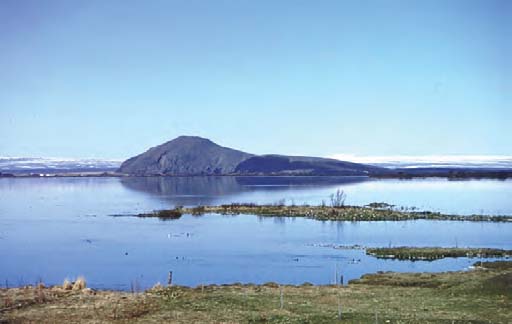 3 Myvatn, the “Fly Lake” of Iceland, famous for its breeding water birds
3 Myvatn, the “Fly Lake” of Iceland, famous for its breeding water birds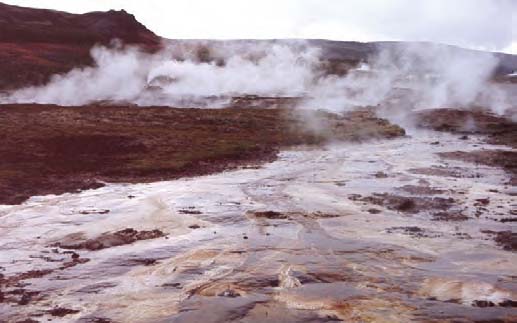 4 Hot springs, Geysir, Iceland
4 Hot springs, Geysir, Iceland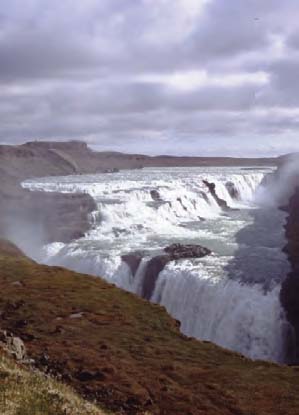 5 Gullfoss, Iceland
5 Gullfoss, Iceland